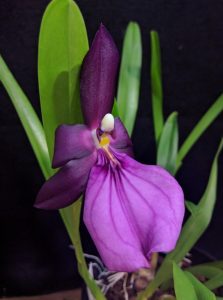Miltonia spectabilis is a truly lovely species when in flower, but is definitely not grown by enough people. There are a couple of reasons for this. The first is that the whole genus Miltonia is overshadowed by the practically impossible to grow and ubiquitous Miltoniopsis. Secondly, the plants are sprawling, badly behaved and untidy.
There is a little confusion over the whole Miltonia spectabilis complex, and some authorities now consider Miltonia spectabilis var. moreliana to be a species in its own right, M. moreliana. I grow both, and there do seem to be differences between the two. Whether they are sufficiently significant to give M. moreliana species status is for taxonomists to decide. For the time being, I shall continue with the old name until I am unequivocally told otherwise. (The monocot checklist of the Royal Botanic Gardens, Kew recognizes it as a distinct species – ed.).
I’m pleased to say that Miltonia spectabilis var. moreliana is much better behaved than the regular species. The internodes between the pseudobulbs are much shorter and the growths are much more upright, making the plant much better suited to pot culture. The internodes are still on the long side, but much more manageable. It grows in my warm grow-room with most of my other orchids, with temperatures in the upper twenties in the day and in the mid- to upper teens at night. I have heard that it is a very tolerant species, and it will probably grow and flower quite a bit cooler than this. As is typical with many Miltonia species, it is quite shallow-rooted and there is no point at all in growing it in anything other than a broad, shallow container. It is also finely rooted, but I generally advise against using too fine a potting material – my plant does well in medium bark chips. Regular repotting is necessary because of the length of the internodes, and the plant quite quickly reaches the edges of its container. It has a pleasing habit of frequently ‘breaking double’ and regularly produces two growths from its leading pseudobulb, with the result that plants can either be fairly frequently divided or will quickly grow into nice specimens. A favourite trick of mine is to leave the plant in its pot and make a back-cut a few pseudobulbs back on the rhizome so as to force the plant to make new growth toward the back, where there are often no leaves or flowers.
The blooms are borne on single-flowered inflorescences as the new growths mature. Spikes appear to be quite slow to develop, but at least the blooms are long-lasting when they finally open. I prefer the species to all of its hybrids because although it passes on the lovely purple colour, it also passes on the low flower count and the hybrid flowers tend to be clustered and crowded at the end of the spikes making the flower spikes rather untidy.
I can heartily recommend this species to anyone who can provide a bit of heat and humidity but this is a plant that will probably also perform perfectly well as a houseplant.
